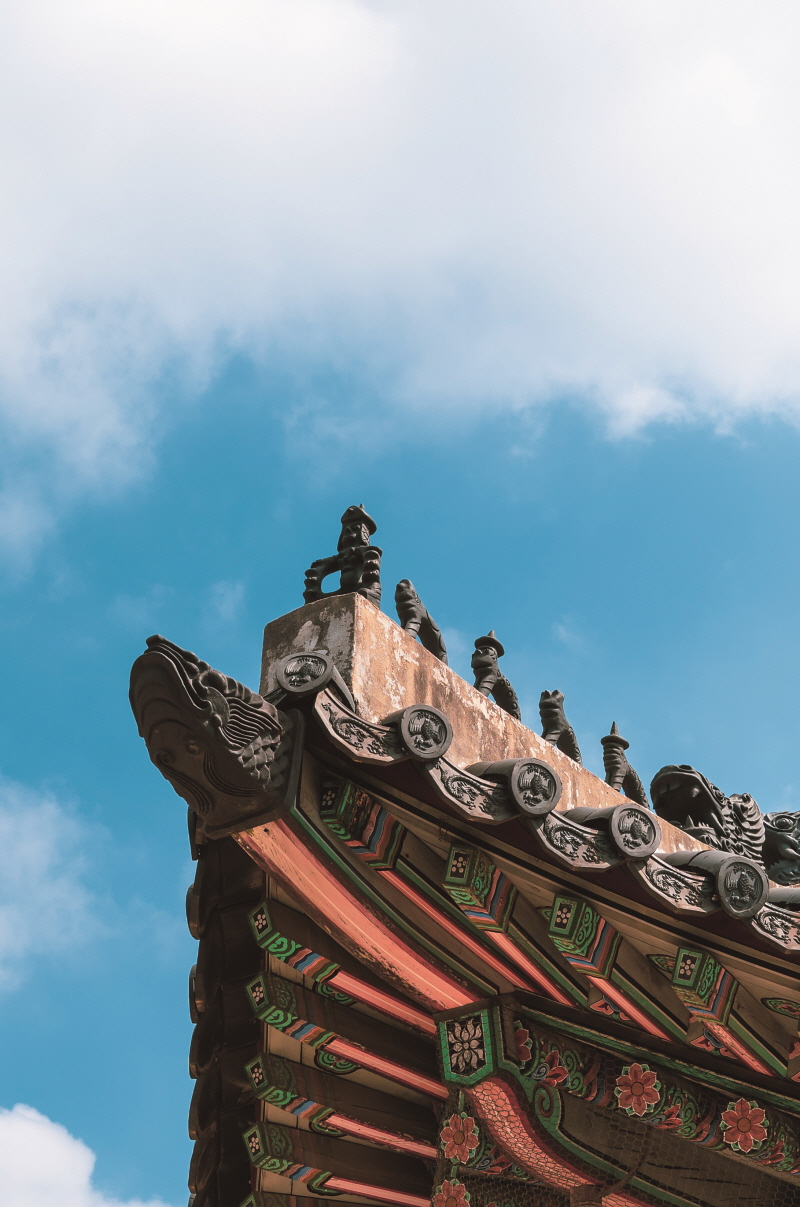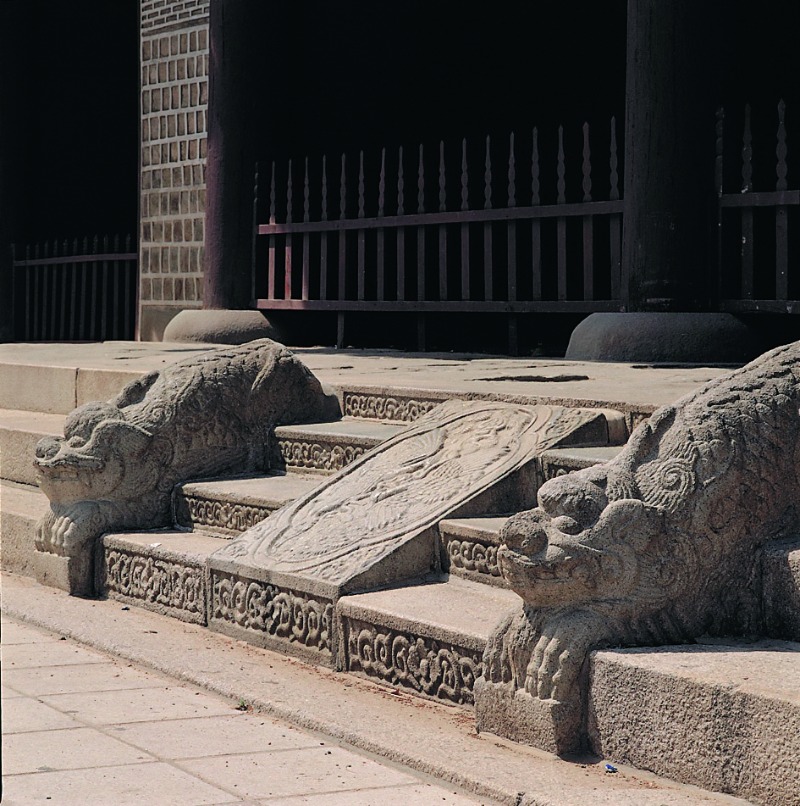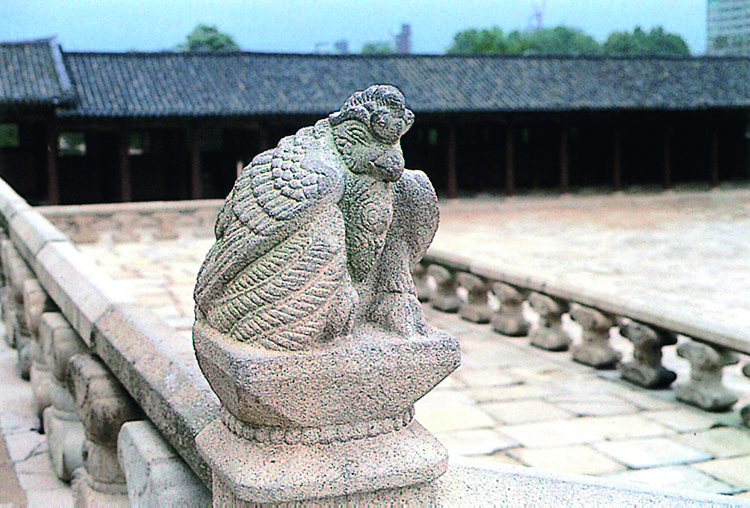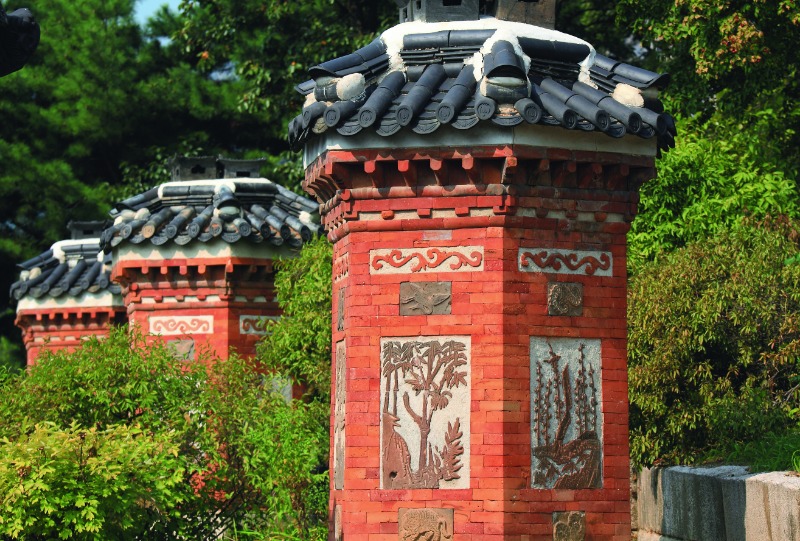Korea’s dynastic thrones are surrounded with stone sculptures and decorations that display outstanding aesthetic beauty. Positioned on a variety of structures, they represent the ideals of Confucian politics, the king’s authority, and the dignity of the royal family.

Animal and human figures are perched on the hips of the palace roof to ward off evil spirits and ensure peace within.
© Huh Yu-jeong, Unsplash
Korea’s ancient palaces are decorated with animal sculptures that express wishes for the nation’s peace, safety, and wise leadership, as well as for the health and longevity of the royal family. The stone, earth, and metal works are inspired by folktales and radiate imagined prowess. Gyeongbok Palace, the main royal palace of the Joseon Dynasty (1392–1897), has hundreds of stone sculptures, making it a particularly perfect place to learn about their symbolism.
The sculptures found at Gyeongbok Palace were once confined to its expansive grounds. Ordinary people were forbidden from having replicas, as they represented royal authority and the king’s benevolent rule that brought peace across his realm. But rather than a rigid or menacing aura, these sculptures have a measured appearance with a touch of playful humor.
Guardians of the Royal Family

In the middle of the steps in front of Gyeongbok Palace’s Geunjeongmun is a sloping stone to accommodate the king’s palanquin. It is engraved with a phoenix and flanked by stone statues of haechi, a guardian beast.
© Cultural Heritage Administration
Standing in front of Gwanghwamun, the main gate of Gyeongbok Palace, are two stone statues of
haechi, a legendary creature that judges right and wrong, good and bad. They have a scaly, round body; a large bulbous nose; big, protruding eyes; hair hanging below their ears; and sets of fangs and claws. What appears to be a sheep’s horn protrudes from and a bell is wrapped around each haechi’s neck. Still, the creatures do not appear threatening but seem to be smiling.
The haechi statues are believed to have been built during the reconstruction of the palace between 1865 and 1867. Like the scales of justice in the West, the haechi was regarded as a symbol of law and justice. The placement of haechi statues at the main palace gates signified royal authority and the ideals of Confucian politics.
Beyond Gwanghwamun, there is a small stream called Geumcheon. It lies between two gates — Heungnyemun and Geunjeongmun — that open to the main palace grounds. The bridge over the stream, Yeongjegyo, has dragons curled on its balustrade. As a guardians and symbols of royal authority, the dragons are positioned to survey the people crossing the bridge. The creatures clutch a wish-granting pearl with their front feet. Two protruding horns and long beards complete their watchful look.
On the stone embankment of the stream are sculptures of four auspicious animals. Clinging to the edge with their heads thrust forward, they are on the verge of jumping into the water. They have three-pronged horns, eyebrows that are curled round, and large impressive noses. Their bodies are covered in scales and their feet have three toes. People of the late Joseon period believed the animals to be tianlu, mythical Chinese creatures. They were thought to ward off evil spirits and guard the palace from misfortune, as well as help court officials compose themselves before entering the palace.
Once you cross Yeongjegyo, Geunjeongmun and Geunjeongjeon (the Gate and Hall of Diligent Governance) come into view. Geunjeongjeon is where kings were enthroned, received felicitations from civil and military officials, and promulgated important laws. Thus, it was only natural that the largest number of statues of auspicious animals were clustered around the hall. A phoenix encircling a wish-granting pearl is engraved on the path where the king’s palanquin passed. Like the dragon, the phoenix is another symbol of royal authority.

An animal sculpture sits on the stone balustrade of the lunar platform (Woldae) in front of Geunjeongjeon (the throne hall) in Gyeongbok Palace. Animal sculptures symbolizing the four cardinal directions, the four seasons, and the twelve months occupy each of the elevated platform’s columns.
© Cultural Heritage Administration
Various animal sculptures occupy the stone balustrades of a platform in front of Geunjeongjeon. On the top tier are animals symbolizing the four cardinal directions and the four seasons. On the lower tier are animals representing the twelve months, although some animals were left out due to placement issues. At the front corners of the platform are carvings of lion-like animals and their cubs. The imaginary animals symbolize the king’s wisdom and right judgement. There is a large bronze cauldron with three legs and two handles on top of the platform, which has served as a symbol of the legitimacy of royal authority since ancient times.
Peaceful Reign
Various animal sculptures occupied the main area of the palace. They represented all beings and signified that every living creature would live in accordance with the way of nature, each in their place, under the king’s virtuous rule. Divine animals were thought to protect the royal family and symbolized a peaceful reign. Such stone sculptures can also be found at Gyeonghoeru, the royal banquet hall, which sits on an island on a large artificial pond. Three stone bridges connect the hall to the palace grounds. They feature carvings of dragons and giraffes, which represented the king; Imugi (a monster serpent) and Chu-u (an imaginary divine animal) which signified the crown prince; and elephants and haechi, which symbolized benevolent couriers.
When the pond surrounding Gyeonghoeru was dredged in 1997, a bronze dragon sculpture around 1.5 meters long and weighing 66.5 kilograms was discovered. It is thought to have been placed there to guard the palace from fire; Joseon people believed the dragon had the power to control water and bring rain. It is currently on display at the National Palace Museum of Korea.
There were also large cast iron cauldrons (deumeu) propped up on three stone pedestals on the left and right side under the lunar platform of Geunjeongjeon. They were always filled with water so that they could be used to put out fires. In the winter, a fire was lit between the stone pedestals to prevent the water from freezing. A humorous wish also accompanied the cauldrons, with people hoping the fire demon would be startled at its reflection in the water and run away.
Aside from the sculptures, the palace architecture itself is rich in symbolic meaning. Particularly striking are large decorative tiles that rise at an angle at the left and right ends of the ridge of the Geunjeongjeon roof. In ancient times, they were shaped like the tail or head of a bird, but during the Joseon Dynasty, they were carved in the shape of a dragon. This was both a display of royal authority and in accordance with the shamanistic belief that they would protect the palace from fire.
Various other animal figures were also placed on the hips of the roof. The animals, who are said to fight off evil spirits and monsters, are perched on the roof, tasked with the job of warding off misfortune.
Such stone figures were placed only on the roof of palaces or other key state structures, as they represented the power of the royal family. The number of figures varied depending on the importance of the building. Seven each remain intact on the upper and lower sections of the roof of Geunjeongjeon, though research has revealed that more existed in the past.
Symbols of Longevity

Chimneys in the rear garden of Gyotaejeon (the queen’s quarters) in Gyeongbok Palace. They are engraved with the 10 symbols of longevity and the four “gentlemen” plants that signify noble character.
© gettyimagesKOREA
Behind Gangnyeongjeon (the king’s quarters) is Gyotaejeon (the queen’s quarters), and behind that lies the rear garden, Amisan. The garden has a four-tiered stone terrace on which there are a cistern, oddly shaped rocks, and various plants.
Red-brick, hexagon-shaped chimneys connecting to the furnace of Gyotaejeon are installed on the third tier. They have decorative designs that express wishes for the health and longevity of the royal family.
The sun, mountains, clouds, rocks, bamboo, pine, elixir, and chrysanthemums, as well as lotus and grapes adorn the center. These are known as sipjangsaeng, the 10 symbols of longevity, though technically lotus and grapes are symbols of prosperity. In the center are the four “gentlemen” plants (plum blossom, orchid, chrysanthemum, and bamboo). Roe deer, bats, camels, and phoenixes are carved above and below. Tiled roofs sit atop the chimneys with four smoke-emitting devices. The overall appearance is aesthetically pleasing.
To the east of Gyotaejeon lies Jagyeongjeon, the living quarters of the Queen Dowager. It is surrounded by a flower wall that represents the wish for long life. A rectangular chimney, slightly protruding from it, forms part of the wall. It is decorated with the 10 symbols of longevity, between which are engraved cranes, deer, and turtles. Above and below the symbols are various animals that were thought to repel bad luck and bring good fortune. They include bats, which symbolized wealth and honor.